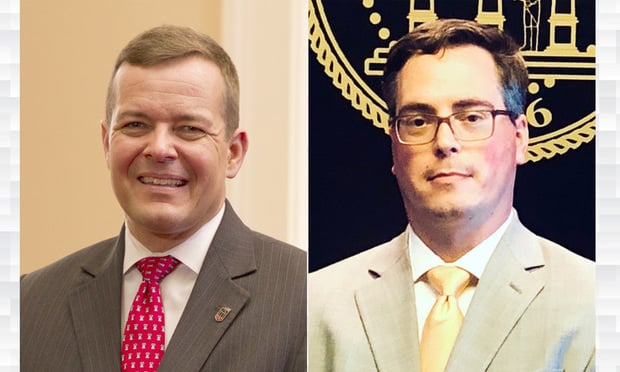Alien Tort Cases Will Survive Supreme Court Trim, Write Commentators
Despite Jesner's holding, several potentially viable avenues for ATS litigation remain.
September 17, 2018 at 11:25 AM
8 minute read
 Peter Rutledge (left) and Michael Baker
Peter Rutledge (left) and Michael Baker
For over four decades, the Alien Tort Statute has served as a central battleground in some of the country's (and world's) most significant international human rights litigation. Following a trend in its ATS jurisprudence that started with its opinion in Sosa v. Alvarez-Machain, the Supreme Court recently trimmed the statute's scope yet further. In Jesner v. Arab Bank PLC, the Court held that suits arising under the ATS did not extend to claims against corporations (at least some of them, a nuance explained below). Once again, postdecisional commentary decried the demise of ATS suits and a blow, more generally, to the cause of human rights.
The reality, however, is much more complex. Despite Jesner's holding, several potentially viable avenues for ATS litigation remain. This essay maps out three anticipated battlegrounds in future ATS litigation in the wake of Jesner.
A first and obvious battleground left open by the Sosa-Jesner line is whether Jesner's holding extends to domestic corporations or is limited to foreign ones. Jesner is especially turgid on this point. In some passages, Justice Anthony Kennedy, writing for a plurality of the court, suggests a narrow scope: “[J]udicial deference requires that any imposition of corporate liability on foreign corporations for violations of international law must be determined in the first instance by the political branches of the Government.” The emphasis in this passage (and elsewhere) ties the holding to concerns about interference in the foreign relations of the United States, a particularly acute matter in cases involving foreign defendants. Elsewhere, when writing for the court, Kennedy's opinion sweeps more broadly, noting that the court's caution about “judicially created private rights of action” extends to “whether the courts should exercise the judicial authority to mandate a rule imposing liability upon artificial entities like corporations.” Passages like this (as well as portions of the plurality opinion addressing analogies to the Torture Victim Protection Act) rest on principles of judicial restraint, principles that apply with equal force regardless of corporate nationality.
In re Chiquita provides an example where these divergent threads in Jesner will be tested. Chiquita began in 2007 with an action by 144 Columbians filing suit under the ATS against Chiquita Brands in the federal court in the District of Columbia. Chiquita Brands made payments to the United Self-Defense Forces of Columbia, also known as the AUC. The AUC was named as a terrorist organization by the United States government in 2001 and 2003. As a result of this designation, Chiquita was sued by the United States, pleading guilty in March 2007 to providing material support and resources to the AUC. The plaintiffs in Chiquita alleged that the payments made by Chiquita to the AUC resulted in the deaths of 173 plaintiffs' relatives, a fraction of the thousands killed by the AUC. Since 2007, Chiquita has blossomed into a massive MDL case, with dozens of large cases, including at least one class action, being transferred to the MDL proceeding in the Southern District of Florida. A key strand of Jesner—whether domestic corporations are liable under the ATS—is likely to be resolved through Chiquita, one of the few remaining ATS complaints yet to be heard on the merits.
A second battleground to be decided by the line of cases that come after Jesner is the issue of individual liability. Regardless of the resolution of the corporate liability question, Jesner makes clear that individuals might be liable in claims arising under the ATS. This possibility aligns ATS jurisprudence with the related TVPA jurisprudence, where the Supreme Court made clear in Mohamad v. Palestinian Authority that liability did not extend to juridical entities like corporations. To be sure, these suits present special challenges, whether prejudgment challenges (like service and personal jurisdiction) or postjudgment ones (like the collectability of any judgment or settlement). These challenges, while daunting, are not necessarily insurmountable.
Argon v. Ku provides a good example of a plausible suit against an individual defendant. In Aragon, 12 foreign Latino plaintiffs sued two CEOs, individually, and five Minnesota corporations owning several chains of grocery stores. The plaintiffs alleged that they were physically restrained at their workplace, threatened with deportation, with some plaintiffs being physically assaulted. The suit was filed under the Civil Rights Act of 1866 and the ATS, among others. The defendants moved to dismiss all the claims but were unsuccessful. Specifically addressing the defendants' claims that the ATS is not applicable against private individuals, the court surveyed sister circuits and, looking to the Second Circuit, found that “certain forms of conduct violate the law of nations whether undertaken by those acting under the auspices of a state or only as private individuals.” Shortly before the case was to proceed to trial, the parties agreed to participate in a settlement conference conducted by the magistrate judge hearing the claim, set for late August 2018.
A third and final battle ground after Jesner is the degree of domestic conduct necessary for the ATS to have effect. This traces to the Supreme Court's earlier decision in Kiobel v. Royal Dutch Petroleum. Building on earlier jurisprudence that toughened the presumption against extraterritorial application of federal law, Kiobel required that any claim arising under the ATS must involve conduct that touches and concerns the territory of the United States “with sufficient force to displace the presumption against extraterritorial application.” While theoretically tempting, Kiobel's formulation left many open questions, including, among others, what satisfied the “touch and concern” requirement and, even when it is satisfied, how a court should decide whether it does so with “sufficient force.” Jesner did little to resolve this confusion.
Salim v. Mitchell provides a good example of how lower court litigation tests the answers to these unresolved questions. In Salim, three foreign plaintiffs sued two psychologists who were employed by the CIA allegedly to design, implement, and personally administer an experimental torture program. The foreign plaintiffs sued the CIA psychologists under the ATS in November 2016, alleging that they were subjected to waterboarding, stress positions, prolonged sleep deprivation, dietary manipulation, cramped confinement, facial and abdominal slaps and being kept nude in below-freezing temperatures. The alleged torture was so severe that one of the plaintiffs died and was represented in the case by his estate. In his memorandum opinion on, and denying, the defendants' motion for summary judgment, Judge Lowe Quackenbush of the U.S. District Court for the Eastern District of Washington specifically recognized the ATS “legal landscape is evolving,” and specifically found that the “touch and concern test of Kiobel” was satisfied. Shortly after, the parties reached a confidential settlement.
In sum, just as commentators wrongly predicted the demise of ATS litigation in the wake of Sosa, so too does similar commentary in the wake of Jesner appear to prematurely predict the demise of ATS litigation. Several battlegrounds will be active. To be sure—these three do not encompass them all. Questions remain about numerous other strands in Sosa. And, in Jesner, several members of the court suggested a certain level of receptivity to reconsidering Sosa. For now, the only certainty is that ATS litigation remains a ripe area for international human rights litigation.
Peter B. “Bo” Rutledge is dean of the University of Georgia School of Law, where he holds the Herman Talmadge Chair of Law. A former clerk to Justice Clarence Thomas of the Supreme Court of the United States, Rutledge pursues teaching and research of international dispute resolution, arbitration, international business transactions and the U.S. Supreme Court.
Michael Baker graduated from the University of Georgia School of Law in May. He now clerks for Judge Ron Mullins on the Superior Courts of the Chattahoochee Judicial Circuit.
This content has been archived. It is available through our partners, LexisNexis® and Bloomberg Law.
To view this content, please continue to their sites.
Not a Lexis Subscriber?
Subscribe Now
Not a Bloomberg Law Subscriber?
Subscribe Now
NOT FOR REPRINT
© 2025 ALM Global, LLC, All Rights Reserved. Request academic re-use from www.copyright.com. All other uses, submit a request to [email protected]. For more information visit Asset & Logo Licensing.
You Might Like
View All
A Plan Is Brewing to Limit Big-Dollar Suits in Georgia—and Lawyers Have Mixed Feelings
10 minute read

Trending Stories
- 1'Lookback Window' Law for Child Abuse Cases Constitutional, State High Court Finds
- 2Troutman Pepper Says Ex-Associate Who Alleged Racial Discrimination Lost Job Because of Failure to Improve
- 3Texas Bankruptcy Judge Withdraws Ethics Complaint Against Jackson Walker
- 4Apply Now: Superior Court Judge Sought for Mountain Judicial Circuit Bench
- 5Harrisburg Jury Hands Up $1.5M Verdict to Teen Struck by Underinsured Driver
Who Got The Work
J. Brugh Lower of Gibbons has entered an appearance for industrial equipment supplier Devco Corporation in a pending trademark infringement lawsuit. The suit, accusing the defendant of selling knock-off Graco products, was filed Dec. 18 in New Jersey District Court by Rivkin Radler on behalf of Graco Inc. and Graco Minnesota. The case, assigned to U.S. District Judge Zahid N. Quraishi, is 3:24-cv-11294, Graco Inc. et al v. Devco Corporation.
Who Got The Work
Rebecca Maller-Stein and Kent A. Yalowitz of Arnold & Porter Kaye Scholer have entered their appearances for Hanaco Venture Capital and its executives, Lior Prosor and David Frankel, in a pending securities lawsuit. The action, filed on Dec. 24 in New York Southern District Court by Zell, Aron & Co. on behalf of Goldeneye Advisors, accuses the defendants of negligently and fraudulently managing the plaintiff's $1 million investment. The case, assigned to U.S. District Judge Vernon S. Broderick, is 1:24-cv-09918, Goldeneye Advisors, LLC v. Hanaco Venture Capital, Ltd. et al.
Who Got The Work
Attorneys from A&O Shearman has stepped in as defense counsel for Toronto-Dominion Bank and other defendants in a pending securities class action. The suit, filed Dec. 11 in New York Southern District Court by Bleichmar Fonti & Auld, accuses the defendants of concealing the bank's 'pervasive' deficiencies in regards to its compliance with the Bank Secrecy Act and the quality of its anti-money laundering controls. The case, assigned to U.S. District Judge Arun Subramanian, is 1:24-cv-09445, Gonzalez v. The Toronto-Dominion Bank et al.
Who Got The Work
Crown Castle International, a Pennsylvania company providing shared communications infrastructure, has turned to Luke D. Wolf of Gordon Rees Scully Mansukhani to fend off a pending breach-of-contract lawsuit. The court action, filed Nov. 25 in Michigan Eastern District Court by Hooper Hathaway PC on behalf of The Town Residences LLC, accuses Crown Castle of failing to transfer approximately $30,000 in utility payments from T-Mobile in breach of a roof-top lease and assignment agreement. The case, assigned to U.S. District Judge Susan K. Declercq, is 2:24-cv-13131, The Town Residences LLC v. T-Mobile US, Inc. et al.
Who Got The Work
Wilfred P. Coronato and Daniel M. Schwartz of McCarter & English have stepped in as defense counsel to Electrolux Home Products Inc. in a pending product liability lawsuit. The court action, filed Nov. 26 in New York Eastern District Court by Poulos Lopiccolo PC and Nagel Rice LLP on behalf of David Stern, alleges that the defendant's refrigerators’ drawers and shelving repeatedly break and fall apart within months after purchase. The case, assigned to U.S. District Judge Joan M. Azrack, is 2:24-cv-08204, Stern v. Electrolux Home Products, Inc.
Featured Firms
Law Offices of Gary Martin Hays & Associates, P.C.
(470) 294-1674
Law Offices of Mark E. Salomone
(857) 444-6468
Smith & Hassler
(713) 739-1250







